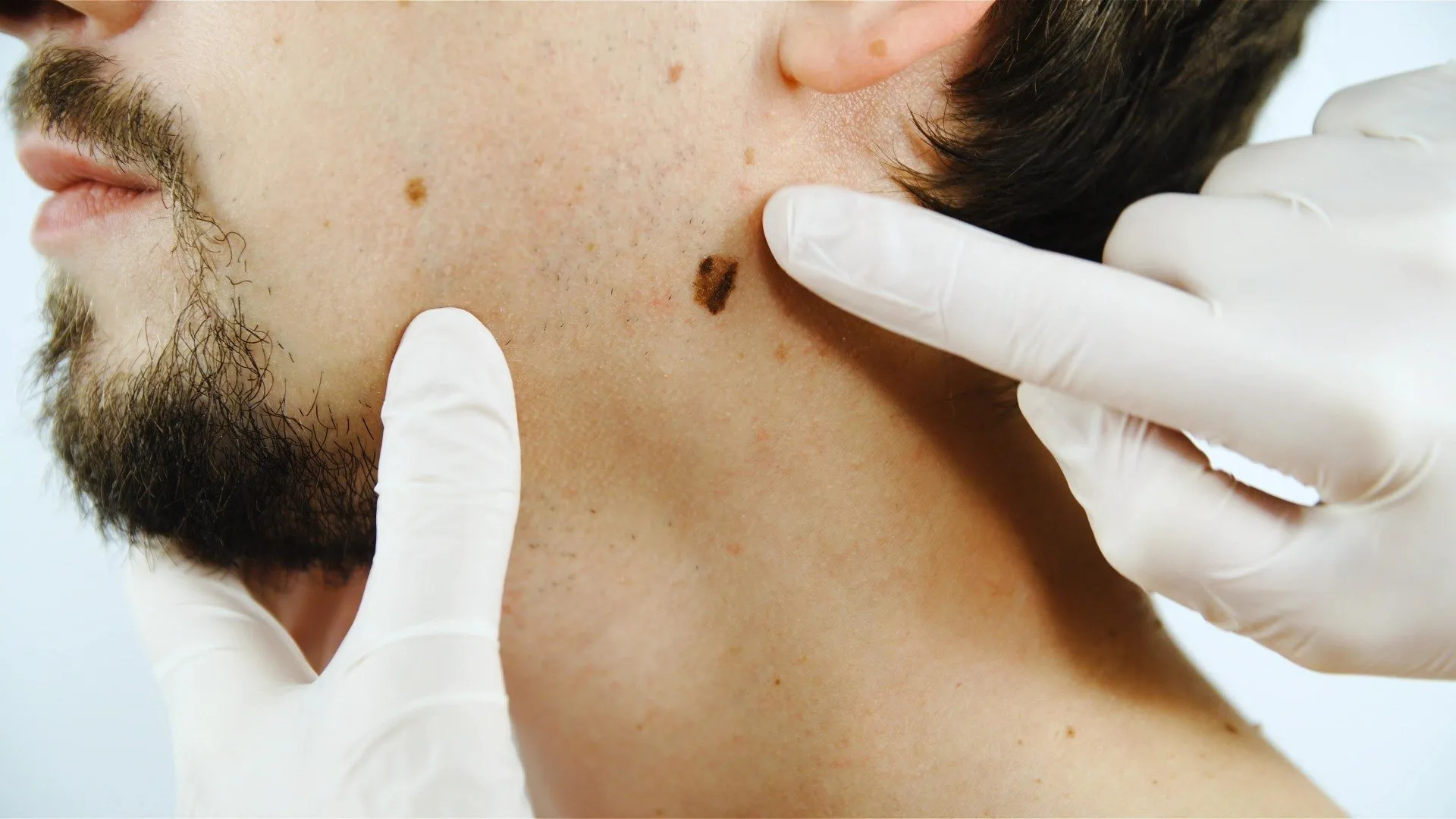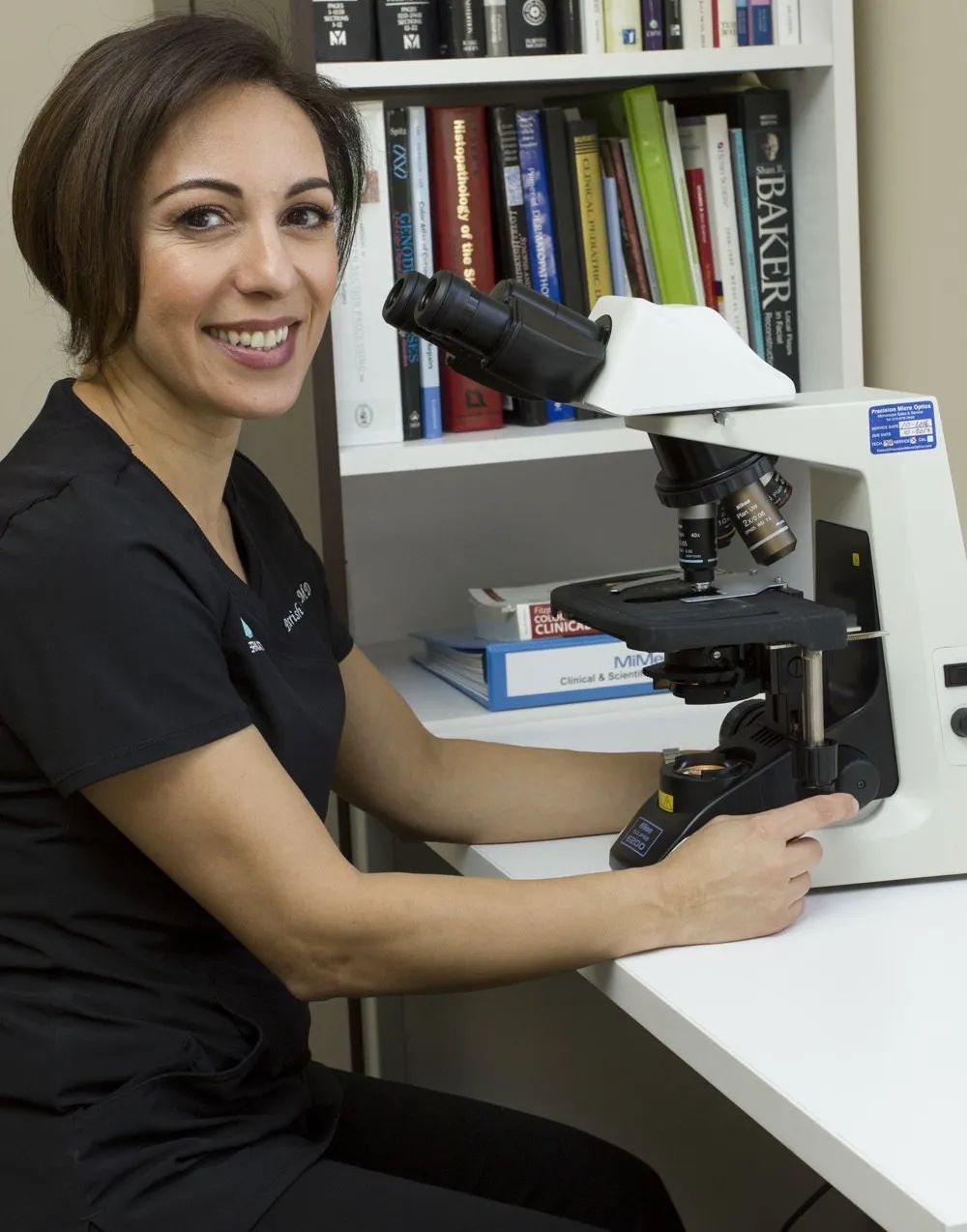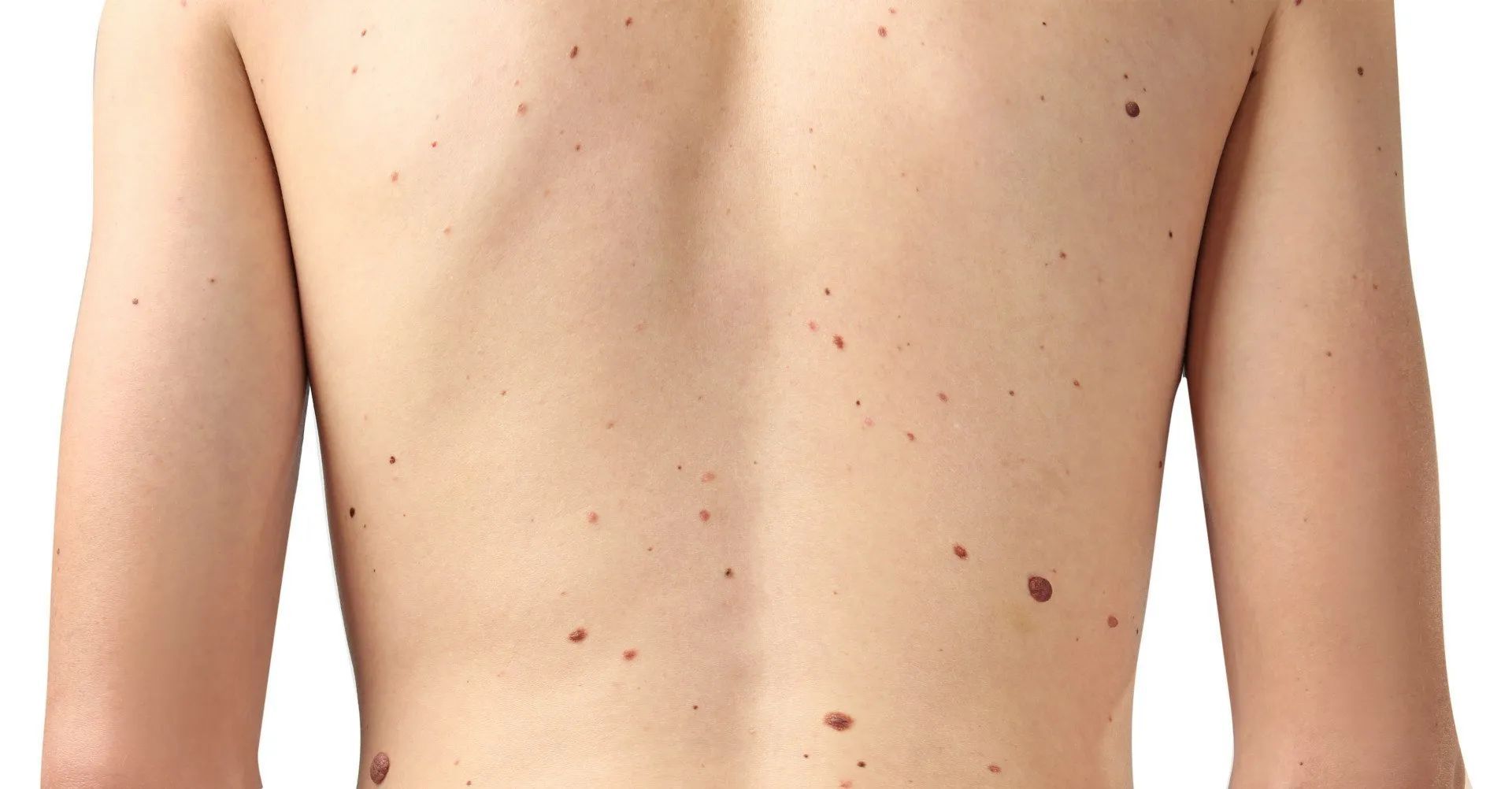Mohs Micrographic Surgery for Skin Cancer Removal
What is Mohs Skin Cancer Treatment?
Mohs micrographic surgery is a highly-specialized, precise technique for removing skin cancer while preserving as much healthy tissue as possible. Ideal for sensitive and visible areas like the face, neck, and hands, Mohs surgery offers the highest cure rate for many types of skin cancer, including basal cell carcinoma, squamous cell carcinoma, and some types of melanoma.
Dr. Parrish Sadeghi is double-board certified and specially trained in the Mohs procedure. Contact Pure Dermatology today for your skin cancer consultation.
How the Mohs Procedure Works
The American Academy of Dermatology states that 1 in 5 Americans will be diagnosed with skin cancer at some point in their lives. If you find yourself dealing with a skin cancer diagnosis, you can take comfort in knowing there is a highly effective treatment available for many types of skin cancer: Mohs micrographic surgery.
Mohs surgery was named after the pioneering physician who first designed the technique of removing types of skin cancer one layer at a time, while preserving as much healthy tissue as possible. While skin cancer is the most common type of cancer in the world, the Mohs procedure is the most effective treatment with the highest cure rate. What makes it a top choice for patients?
Precision Targeting for Sensitive Areas
Micrographic surgery like the Mohs procedure removes one layer of skin at a time. This helps physicians take only what is necessary, and conserves healthy tissue while preserving the natural appearance of your skin.
Efficacy in Skin Cancer Treatment
Out of all skin cancer treatments and surgical procedures, Mohs has the highest cure rate with the least amount of side effects. Patients can expect to return to their normal lives quickly, and will have the peace of mind of long-lasting results.
Safe, Low-Risk Skin Cancer Surgery
Because the Mohs procedure is performed in-office with local anesthetic, it requires very little downtime while also eliminating the risks of going under general anesthesia.
Conditions Helped by Mohs
Mohs surgery is used to treat several common types of skin cancer. If you’re diagnosed with these types of skin cancers, your physician may recommend the following Mohs procedures:
Basal Cell Carcinoma Treatment
This type makes up 80% of all skin cancers, and when caught early, is easily treatable. It affects the top layer of the skin, and is most often caused by sun exposure or radiation.
Squamous Cell Carcinoma Treatment
Also caused by sun exposure, squamous cell carcinoma can go deeper into the skin than basal cell, and is also more likely to spread. However, it still has a very high cure rate, especially when diagnosed in the early stages.
Melanoma Removal
Melanoma is the most dangerous type of skin cancer and develops from the cells that produce melanin, which gives our skin its pigment. Not all melanomas can be treated with Mohs surgery, but when found early, it may be an effective treatment option.
Where can the Mohs Procedure be Applied?
Many patients seek out Mohs treatment because it is ideal for the sensitive areas in which basal cell or squamous cell carcinomas are frequently found. It is also commonly used on spots that are at a high risk for recurrence. Places the Mohs procedure can be performed include:
- Back
- Face
- Neck
- Hands
- Feet
- Ankles
- Shins
- Genitals

Why Choose Pure Dermatology for Mohs Skin Cancer Surgery?
Skin cancer is a scary diagnosis — we understand. We also know that skin cancer in delicate or highly visible areas can cause additional concerns. Dr. Parrish Sadeghi knows what you’re going through, and she is highly-trained to guide you through the journey.

Meet Dr. Parrish Sadeghi: Santa Monica’s Board-Certified, Fellowship-Trained Mohs Surgeon
- Advanced Fellowship Training
- Board Certification
- Patient-Centered Care
Dr. Parrish Sadeghi is a dedicated, double board-certified dermatologist specializing in Mohs micrographic surgery. With extensive fellowship training in this advanced technique, Dr. Sadeghi combines technical precision with an individualized approach, ensuring patients receive the best care possible.
Dr. Sadeghi’s Background and Expertise
Dr. Sadeghi completed a rigorous fellowship in Mohs surgery and advanced dermatologic oncology, equipping her with the skills to treat a wide range of skin cancers. Her commitment to excellence is evident in her meticulous approach to surgery and her compassionate patient care. Dr. Sadeghi prioritizes her patients' comfort and wellbeing, focusing on achieving both outstanding clinical outcomes and optimal cosmetic results.
The Mohs Procedure:
What to Expect
Mohs treatment can vary from patient to patient, but most of the time, you’ll experience the procedure in four steps:

Step 1: Skin Cancer Consultation
Dr. Sadeghi will meet with you to discuss your medical history and answer your questions about your specific skin cancer type and the Mohs procedure. She will also give you any preoperative instructions and information on aftercare.
Step 2: Mohs Preparation
On the day of your treatment, the skin around your cancer lesion or tumor will be cleansed and prepped. You will receive local anesthesia in the area of the skin cancer, which will numb the skin. You will be awake and aware throughout the procedure.
Step 3: Skin Cancer Treatment
During Mohs treatment, the outline of the cancerous lesion is traced with the surgical instrument to ensure precision. One layer of skin is removed at a time, so Dr. Sadeghi can preserve healthy tissue in the vicinity. Most Mohs procedures begin in the morning and wrap up later the same day.
Step 4: Mohs Aftercare
Aftercare will depend on the size of the post-treatment wound. Some only need to be kept clean and sterile, while others may require stitches. In cases of larger cancerous areas, a skin graft may be required. Dr. Sadeghi will walk you through all post-operative care needs, and will discuss any future needs for reconstruction, though this is rare.
Mohs Results
Mohs micrographic surgery has an extremely high cure rate of up to 99%. While scarring is possible based on the area of skin removed and whether stitches are required, Mohs is focused on preserving as much healthy skin tissue as possible.
Mohs Before & After Photos
Visit our gallery to view a lineup of before and after photos from Dr. Sadeghi’s Mohs patients.
Typical Costs of Mohs Micrographic Surgery
The costs of Mohs treatment depends on many factors, including the size and scope of the skin cancer, how many treatments are needed, and the patient’s insurance coverage. We can work with you to give you a clearer estimate at the time of your consultation, so you have a better idea of what to expect.
Preparing for Skin Cancer Treatment
To prepare for a Mohs procedure, there is very little you need to do, other than rest and know that you’re in good hands with Dr. Sadeghi, who has completed thousands of successful Mohs procedures. Show up on time, well-rested and hydrated, and Dr. Sadeghi will take it from there. Avoid wearing any makeup, creams, or lotions on your skin in the area or areas to be treated.
After Your Mohs Procedure
Aftercare depends on how extensive your treatment was, and what wound care is required. Small areas should heal easily on their own, but larger areas will need stitches to ensure they close and heal properly. If stitches are required, Dr. Sadeghi will provide instructions on how to care for them and treat the wound until they can be removed. Similarly, if the wound requires a skin graft or flap, Dr. Sadeghi will ensure you are well-informed on how to care for it as it heals. In cases where the cancer has spread deeper into sensitive tissue such as the eyelid or nose cartilage, Dr. Sadeghi will bring in other specialists to discuss reconstruction.
Mohs FAQ
Here are some of the most common questions patients have about Mohs procedures:
Do I need Mohs micrographic surgery for skin cancer treatment?
You may need Mohs micrographic surgery for basal cell carcinoma treatment, squamous cell carcinoma treatment, or melanoma removal. If you suspect a spot or lesion on your skin may be cancerous, see your physician, or schedule a skin cancer screening with a board-certified dermatologist like Dr. Sadeghi.
Why should I choose a fellowship-trained, certified Mohs surgeon?
Mohs surgeons undergo extensive training to treat skin cancer patients, far above the already-rigorous education and training of other dermatologists. The Mohs College offers a competitive and prestigious fellowship program to select dermatologists so they may train to become certified Mohs surgeons. These qualifications give patients peace of mind and can assure them their treatment will be effective and long-lasting.
Is reconstructive surgery required after Mohs?
Reconstructive surgery is not common after Mohs treatment, unless the skin cancer is in a difficult area such as the eyelid or nose cartilage. In those cases, a specialists will be brought in to discuss reconstructive options. Most of the time, wounds from Mohs surgery heal on their own, or with the aid of a few stitches.
Are Mohs procedures painful?
Mohs procedures aren’t extremely painful due to the local anesthetic used through the treatment. If you have concerns, discuss these at your consultation. Some patients may have discomfort after the procedure and as the wound heals, though most are able to return to their normal lives and routines immediately after surgery.
Can I have Mohs surgery on my nose?
Yes, you can have Mohs surgery on the nose, and on other very delicate areas. This is what makes Mohs procedures so appealing to many patients. The surgery is designed to be minimally invasive and leave minimal scarring, so surrounding healthy tissue is unaffected.
Can I have Mohs surgery on my face?
Yes, you can have Mohs surgery on your face. The types of skin cancer commonly treated by Mohs procedures are often found on the face and surrounding areas, like the neck or ears. These areas are delicate, but all are prime candidates for Mohs treatment.
Healthy, Cancer-Free Skin in Within Reach
At Pure Dermatology, we know that “it’s skin cancer” is the last thing any patient wants to hear. But if that is your diagnosis, know that there is hope and there is healing with Mohs micrographic surgery. Our own Dr. Sadeghi is a highly-qualified and certified Mohs surgeon, and she has the knowledge, experience, and compassion to walk through this journey by your side. If you have a spot that concerns you or you’ve had another physician tell you it may be skin cancer, set up a consultation with Dr. Sadeghi today.



